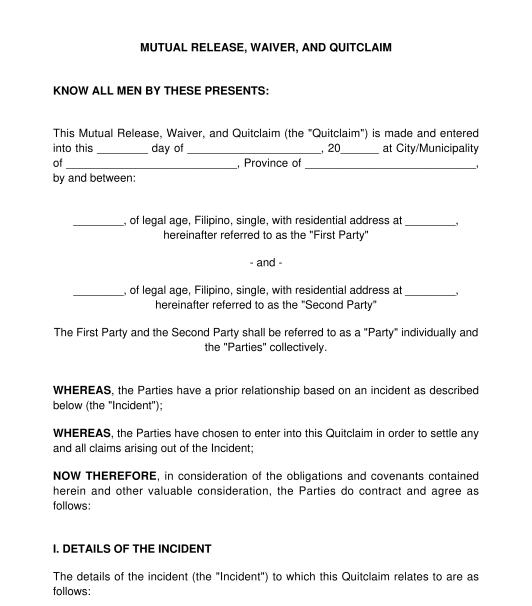 09/20/2025
09/20/2025

Answer a few questions and your document is created automatically.

Your document is ready! You will receive it in Word and PDF formats. You will be able to modify it.

 09/20/2025
09/20/2025
 Word and PDF
Word and PDF
 4 to 6 pages
4 to 6 pages
A Mutual Release, Waiver, and Quitclaim is used when both parties are releasing each other from any liability or obligations connected to or arising from a specific incident.
A Release, Waiver, and Quitclaim is usually given to settle a dispute between the Parties out of Court.
In signing a Release, Waiver, and Quitclaim, the parties do not actually have to admit liability. In fact, this document has the option to specifically confirm that they are not admitting any liability.
However, without actually admitting any liability, a Release, Waiver, and Quitclaim, signed by the parties releases each other from all relevant liabilities connected to the specific incident for which the Release, Waiver, and Quitclaim was signed. In return, the one or both of the parties may agree to provide some kind of compensation to the other. This compensation is usually in the form of money but other goods and services may also be used as compensation.
Once a Release, Waiver, and Quitclaim is signed by the parties, neither party can take further action against the other party, in connection to the specific incident. This means that the parties may be giving up some of their legal rights. Therefore, if the parties have any concerns about this, they should seek legal advice.
This document is specifically drafted for a situation where both parties are releasing the other party from liability in a non-employment situation. If only one party is releasing the other party from liability in a non-employment situation, then a Release, Waiver and Quitclaim (One Way) should be used. If the Release, Waiver, and Quitclaim is connected to an employment situation, then a Release, Waiver, and Quitclaim for employment purposes should be used.
The user should enter all the information required to complete the document. Once completed, the parties should review the document and, if all the information is found to be correct, sign the same.
If either or both parties are an organization or business, such as a corporation, partnership, or sole proprietorship, the said party should authorize a person (the "Representative") to sign the document.
The Representative is usually a person within the organization of the said party. When signing the Release, Waiver, and Quitclaim, the Representative should attach the document showing their authority.
If the said party is a corporation, this document is usually a Secretary's Certificate showing a Board Resolution authorizing the Representative to sign the document. If the said party is organized as a partnership, then it is usually a Partners' Certificate, and if the said party is organized as a sole proprietorship, then it could be a Special Power of Attorney.
Notarizing the document
If the parties want to acknowledge the document, this document also contains an Acknowledgment. An Acknowledgment is an act of a person before a notary public stating that the signature on a document was voluntarily affixed by him and he executed the document as his free and voluntary act.
Acknowledging the document is optional however, a document that is acknowledged before a notary public turns the document into a public document. Public documents are generally self-authenticating, meaning no other evidence will be needed to prove that the parties signed the Release, Waiver, and Quitclaim.
If the document will be acknowledged, the parties (or their respective representatives) should present themselves before a notary public with all the original copies of the document and their attachments, if applicable, and swear an oath to the foregoing. The parties (or their respective representatives) should also bring a competent form of identification, such as a passport or driver's license. A competent form of identification is a current identification document bearing the photograph and signature of the parties (or their respective representatives) and should have been issued by an official agency.
If the document is acknowledged, the notary public will keep one original copy of the document. Both parties should each keep a copy of the document for their records.
There are no laws that apply specifically to a Release, Waiver, and Quitclaim however, the general laws on contracts and obligations found in the Civil Code of the Philippines may apply.
You fill out a form. The document is created before your eyes as you respond to the questions.
At the end, you receive it in Word and PDF formats. You can modify it and reuse it.
Guides to help you
Mutual Release, Waiver, and Quitclaim - sample template
Country: Philippines